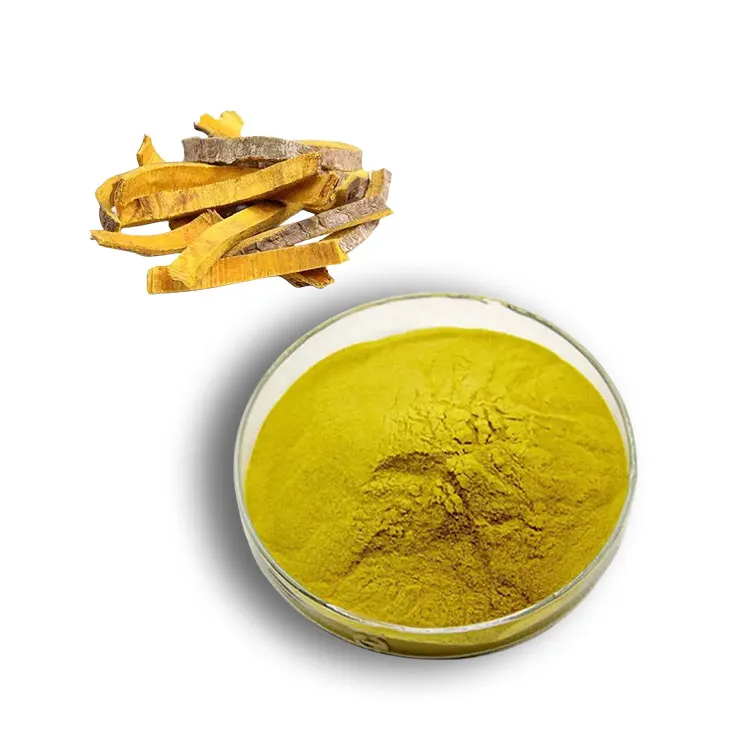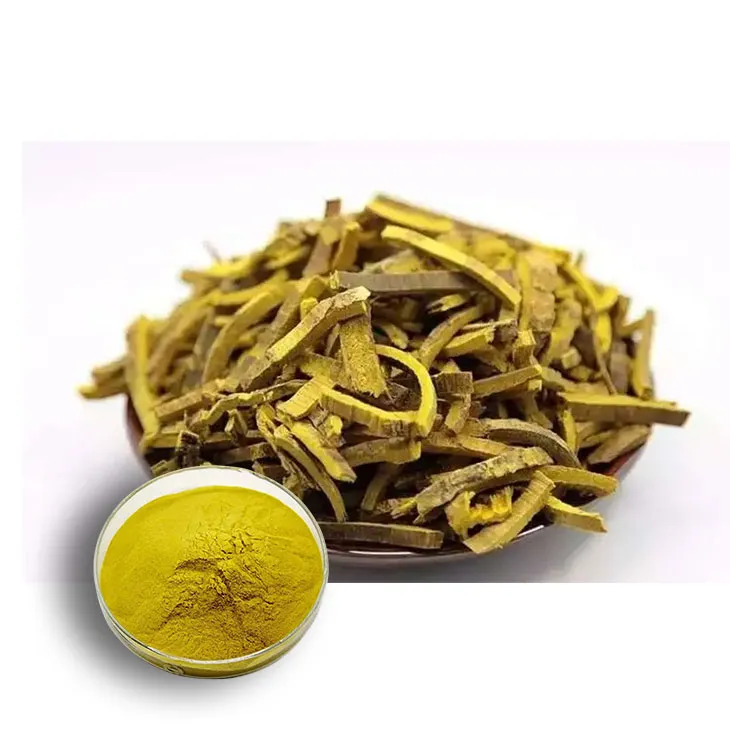- 0086-571-85302990
- sales@greenskybio.com
4 Things Consumers and Manufacturers Should Know about Phellodendron Extract.
2024-12-12

1. Safety Considerations
Allergic Reactions: Consumers and manufacturers should be aware that some individuals may be allergic to Phellodendron amurense extract. Allergic symptoms can range from mild skin rashes to more severe respiratory problems. Manufacturers need to clearly label their products to indicate the presence of this extract, so that consumers with known allergies can avoid it.
Dosage and Toxicity: While Phellodendron amurense has been used in traditional medicine, excessive use of its extract may lead to potential toxicity. For consumers, it is crucial to follow the recommended dosage on product labels. Manufacturers, on the other hand, are responsible for conducting proper research to determine safe dosage levels and communicating this information clearly to the public.
Interactions with Medications: This extract may interact with certain medications. For example, it could potentially interfere with the effectiveness of some prescription drugs. Consumers who are taking medications should consult their healthcare providers before using products containing Phellodendron amurense extract. Manufacturers should also conduct studies to understand these interactions better and include relevant warnings on their product packaging.

2. Usage and Applications
2.1. In Traditional Medicine
Phellodendron amurense extract has a long history of use in traditional medicine, particularly in Asian cultures. It has been used to treat various ailments such as inflammation, fever, and digestive disorders. For consumers interested in traditional medicine, understanding these historical uses can provide insights into its potential benefits. However, it is important to note that traditional uses do not always translate to modern - day medical efficacy.
2.2. In Cosmetics
The extract is increasingly being used in the cosmetics industry. Its anti - inflammatory and antibacterial properties make it a valuable ingredient in skincare products. For example, it can be found in creams and lotions designed to treat acne or soothe irritated skin. Manufacturers in the cosmetics industry need to ensure that they source high - quality Phellodendron amurense extract and adhere to strict quality control standards during the production process.
2.3. In Dietary Supplements
As a dietary supplement, Phellodendron amurense extract is promoted for its potential health - promoting properties. However, consumers should be cautious when choosing dietary supplements containing this extract. They should look for products from reputable manufacturers that have been tested for purity and potency. Manufacturers are required to comply with relevant regulations regarding dietary supplement production, including proper labeling and ingredient disclosure.

3. Sourcing of Phellodendron amurense Extract
Sustainable Harvesting: Manufacturers should be committed to sustainable sourcing of Phellodendron amurense for extract production. This plant is a natural resource, and over - harvesting can lead to depletion of its population in the wild. Sustainable harvesting practices involve careful management of the plant's growth environment, such as proper spacing between plants during cultivation and limited harvesting quantities to ensure the long - term survival of the species.
Quality of Raw Materials: The quality of the Phellodendron amurense used for extraction can vary depending on factors such as the plant's origin, growth conditions, and harvesting time. High - quality raw materials are essential for producing effective and safe extract. Manufacturers should establish strict quality control procedures to ensure that they source only the best - quality plants. This may involve partnering with reliable suppliers who can provide detailed information about the origin and cultivation methods of the plants.
Certifications and Standards: Consumers and manufacturers should be aware of relevant certifications and standards for Phellodendron amurense extract. For example, organic certifications can indicate that the plant has been grown without the use of synthetic pesticides and fertilizers, which may be preferred by some consumers. Manufacturers should strive to obtain these certifications to enhance the marketability of their products.

4. Market Trends
Increasing Demand: There is a growing trend in the demand for Phellodendron amurense extract, both in the domestic and international markets. This is driven by increasing awareness of its potential health benefits and its expanding applications in various industries. Manufacturers should be prepared to meet this increasing demand while maintaining product quality.
Competition: As the market for Phellodendron amurense extract grows, so does the competition among manufacturers. To stay competitive, manufacturers need to focus on product differentiation, such as through research and development to discover new applications or improve the quality of their existing products. Consumers, on the other hand, can benefit from this competition as it may lead to lower prices and a wider variety of products to choose from.
Regulatory Changes: The regulatory environment surrounding Phellodendron amurense extract is constantly evolving. Manufacturers need to stay up - to - date with relevant regulations regarding product safety, labeling, and marketing. Failure to comply with these regulations can result in legal issues and damage to the company's reputation. Consumers can also be more confident in products that are compliant with regulatory requirements.

FAQ:
What are the potential health benefits of Phellodendron amurense extract?
The Phellodendron amurense extract may have several potential health benefits. It has been traditionally used in some herbal medicine systems for its anti - inflammatory properties, which may help in reducing inflammation in the body. It also may have antimicrobial effects, potentially helping to fight against certain bacteria and fungi. Additionally, some studies suggest it could have antioxidant properties, which can assist in neutralizing harmful free radicals in the body.
Are there any safety concerns associated with Phellodendron amurense extract?
While Phellodendron amurense extract is generally considered safe for most people when used appropriately, there are some potential safety concerns. Some individuals may experience allergic reactions, especially those with a history of allergies to related plants. Also, excessive consumption may lead to side effects such as gastrointestinal discomfort. Pregnant and breastfeeding women should be cautious, as there is not enough research to fully determine its safety during these periods.
How should Phellodendron amurense extract be used?
The usage of Phellodendron amurense extract can vary depending on the form (e.g., capsules, tinctures, or powders) and the intended purpose. If it is in the form of a dietary supplement, it is important to follow the recommended dosage instructions on the product label. It can be taken orally, usually with water. However, it should not be used as a substitute for medical treatment without consulting a healthcare professional.
Where can manufacturers source high - quality Phellodendron amurense extract?
Manufacturers can source high - quality Phellodendron amurense extract from reliable suppliers who follow good agricultural and collection practices. Some areas where Phellodendron amurense is native, such as parts of Asia, may be sources. However, it is crucial that the sourcing is sustainable and legal. Suppliers should ensure proper cultivation, harvesting, and processing methods to maintain the quality and integrity of the extract. This may involve working with farmers who adhere to organic or sustainable farming practices and have proper quality control measures in place during extraction and production.
What are the current market trends for Phellodendron amurense extract?
The market for Phellodendron amurense extract is showing growth trends. There is an increasing interest in natural and herbal products in the health and wellness industry, which has led to a greater demand for this extract. It is being incorporated into various products such as dietary supplements, skincare products (due to its potential antioxidant and anti - inflammatory properties for skin health), and traditional herbal remedies. However, the market also faces challenges such as regulatory compliance and ensuring the authenticity and quality of the extract in a competitive market.
Related literature
- The Pharmacological Properties of Phellodendron amurense: A Review"
- "Sourcing and Quality Control of Herbal Extracts: The Case of Phellodendron amurense"
- "Market Trends in Herbal Extracts: Phellodendron amurense in the Spotlight"
- ▶ Hesperidin
- ▶ citrus bioflavonoids
- ▶ plant extract
- ▶ lycopene
- ▶ Diosmin
- ▶ Grape seed extract
- ▶ Sea buckthorn Juice Powder
- ▶ Beetroot powder
- ▶ Hops Extract
- ▶ Artichoke Extract
- ▶ Reishi mushroom extract
- ▶ Astaxanthin
- ▶ Green Tea Extract
- ▶ Curcumin Extract
- ▶ Horse Chestnut Extract
- ▶ Other Problems
- ▶ Boswellia Serrata Extract
- ▶ Resveratrol Extract
- ▶ Marigold Extract
- ▶ Grape Leaf Extract
- ▶ blog3
- ▶ blog4
- ▶ blog5
-
Pure 85% Tomentil Extract.
2024-12-12
-
Marigold Extract
2024-12-12
-
Saw Palmetto Extract
2024-12-12
-
Troxerutin
2024-12-12
-
Cocoa Extract
2024-12-12
-
Ginseng Root Extract
2024-12-12
-
Andrographis Paniculata Extract Powder
2024-12-12
-
Lemon Extract
2024-12-12
-
Scutellaria Extract
2024-12-12
-
Medicinal Marshmallow Extract
2024-12-12
-
Oyster Mushroom Extract Powder
2024-12-12





















